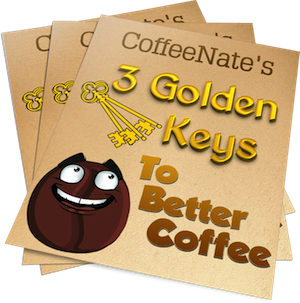Learn how to love coffee

Make Better Coffee
Complete this simple form to get Nate's email mini-series and absolutely transform your coffee experience!
COFFEE DEALS!
Coffee Friends
Categories
- Announcements
- Black Friday Deals
- Brewing Methods
- Coffee & Health
- Coffee Accessory Reviews
- Coffee Brewer Reviews
- Coffee Certification Programs
- Coffee Commentary
- Coffee Events
- Coffee Grinder Reviews
- Coffee Humor
- Coffee Origins
- Coffee People
- Coffee Processing
- Coffee Reviews
- Coffee Shop Reviews
- Coffee Terms
- Coffee Tips
- Cyber Monday Deals
- Direct Trade
- espresso
- Espresso Machine Review
- Fair Trade
- Get Ready
- Gift Ideas
- Guest Posts
- home roasting
- How To
- Last Minute Deal
- Lists
- Monday Morning Meme
- National Coffee Day Deals
- Podcast
- Premium Coffees
- Single Serve Coffee
Copyright © 2025 · CoffeeNate.com · Privacy Policy




Like Coffee? : The First Steps Towards Loving Coffee
Disclosure: I may receive compensation when readers purchase products after clicking links on this site. This does not affect my opinion or the price you pay, but does help support my work. Reviewed products may have been provided at no cost.
So, you like coffee?
We learned the difference between “like” and “love” in junior high (at least we thought we did). You walked your sweaty-palmed self to the object of your affection, and s/he proceeded to stomp your guts out. Hopefully, your story ended better than mine. The point being, there are millions of people who “LIKE” coffee, but they don’t love it. They may think it’s love, but really they’re just fooling themselves and it’s puppy love. So how does one develop a deeper understanding of the coffee world? Just like everything else, you can learn through trial and error, or my personal favorite, learn from the mistakes that others have made!
Taking the First Step
If you’re already a specialty coffee connoisseur, then this message isn’t for you, but it may come in handy when you want to point someone to an introduction to better coffee. If, however, you’re currently drinking grocery store coffee, or subjecting yourself to $5 coffee drinks, this message is made especially for you. If you’re the latter, you probably do not realize that you are spending almost $2000/year. If you’re the former, do you realize that you are drinking a rancid beverage? The first step is admitting your need of help. Even if you think you are perfectly happy with your current situation, there is always room to improve upon it.
It’s All in the Grind
Most people don’t know that the coffee grinder is actually the most important element to brewing a perfect cup of coffee. Sure, you must start with great beans, and you need to have a decent brewer, but those things will be all for nothing, if you don’t have a suitable grinder. The popular home coffee grinder is a cylindrical looking appliance, with blender looking blades at the bottom. If you are currently using one of these, then you are needlessly drinking a poorly brewed beverage. All home brewing folks need a reliable, burr grinder. Why? There is only a percentage of the coffee bean that is soluble, and an even smaller percentage that you want in your cup. For this reason, each brewing method requires a specific, uniform coarseness of the coffee grounds. The blades on the cheapo models cannot possibly be made to create a uniform grind. A poorly ground batch of coffee will see many fines (coffee dust), as well as chunks, leading to too much of the fine particles being dissolved, as well as not enough of the chunkier pieces. Conversely, a properly ground batch of coffee for your brewing method, will result in the optimal amount of the coffee being dissolved into the beverage (extraction).
If you are going to brew regular coffee (non-espresso), then the most economical grinder that I can confidently recommend is the Baratza Encore ($129). To most of you, this may seem like a huge price to pay, but there are grinders that cost thousands! You will also realize an overall savings by having a well constructed grinder that lasts for years, allowing you to brew better coffee at home than in most coffee shops. Additionally, you will also be able to save on the brewer, as most people think that the bulk of their budget should be spent on the brewer. This is simply not the case. If you have $150 for your overall coffee equipment budget, I will tell you to get the grinder and recommend a $20 brewer. If you are strapped for cash, but you don’t mind a bit of an arm workout, I can recommend a $40 manual grinder, The Porlex. This grinder is a great choice for non-espresso folks, and its sturdy construction makes it a great travel grinder too.
Choosing the Right Coffee Maker
There are probably hundreds of different ways to make coffee, but most people opt for the automatic drip coffee maker. While not producing the optimal beverage, it is easy to use. The drawbacks to the auto-drip are internal cleaning/descaling, which is vital to maintain the internal parts as well as providing the best possible taste. Also, many of these brewers do not sufficiently heat the water to attain proper extraction. Personally, I stay away from any brewing system that is enclosed. If I can’t see that the parts are clean, then there is always a nagging voice in my head that is telling me that it’s dirty. Another advantage of manual brewing options, is the level of control over the entire process. I know how hot the water is, I know the equipment is properly cleaned, and I know how long the water is in contact with the ground coffee.
Here are a few options of coffee brewers that are perfect for the beginner, not requiring a great amount of learning, while only requiring a small amount of time and effort.
Off-Topic Plug: CoffeeNate readers can enjoy a 1 year subscription to Hallmark eCards for just $10 (20% savings)! Just use coupon code ECARDS2OFF at checkout. I’m always sending eCards, because they are much cheaper than traditional cards, but much more personal than saying “Happy Birthday” on my friends’ Facebook profiles (along with 500 other people). This 20% offer expires on March 31st, but even at $12, I’ve found this to be a good value.
You NEED Good Coffee
A common mistake that the general public makes, is not thinking of coffee as a food. It was grown on a tree! In general, once the green coffee is roasted, the freshness will last about 2 weeks. For ground coffee, this freshness window is dramatically reduced by 13.9 days. Think about the coffee bean itself as a container, protecting the delicate, flavorful oils inside. When the beans are ground, the oils are exposed to elements that break them down quickly. There is no amount of vacuum sealing that can stop time. Even when packaged under the most optimal conditions, there is a noticeable difference between coffee that was roasted 6 months ago (grocery store beans) and coffee that was roasted 3 days ago. A good rule of thumb is that if the packaging includes an “expiration” date, it’s old. If the package displays the “roasted on” date, it’s usually fresh. Expiration dates are an arbitrary date in the future, usually determined by how long the company expects the coffee to sit on the shelf, and has nothing to do with how fresh the coffee inside is. A roasted on date is placed on the package as a sign of the roaster’s pride in their quality product. This is a general rule, and not a hard and fast rule, but I would only purchase coffee from an unknown or a roaster that I wasn’t referred to, if they are forthcoming with when the coffee was roasted. “Not too long ago” isn’t an acceptable answer! There are companies that I have purchased from often enough, that I know that their coffee is fresh, despite the lack of date stamping.
Many folks report that they were forced to give up drinking coffee, due to digestive issues that were attributed to their coffee drinking. Of course you’re going to experience stomach problems if you’re drinking rancid/stale coffee! It only makes sense. Beyond that, I’ve received hundreds of reports from people who’ve made the switch to fresh roasted coffee, and have never had issues since! Some even report drinking several pots per day. Fresh roasted coffee also provides many naturally occurring chemicals and anti-oxidants that help ward off disease. In fact, there has been a steady stream of studies that show several surprising health benefits for coffee drinkers!
Here are a few of the MANY excellent roasters that I recommend. If I were to include every recommended roaster, it would take pages and pages. Really, I found it surprising that there are so many quality coffee roasters across this continent. If you have a local coffee roaster, I encourage you to also visit their shop and give them a try. If you know coffee, you will be able to determine the roaster’s knowledge and commitment with a short conversation. If they lack the knowledge about where the coffee came from, not the distributor’s name btw, or if all of their beans are dark roasts, those will be signs that you may not want to waste your time and money. If, however, your conversation sparks a light within them and you can see their passion for great coffee, you have likely found a gem.
There you have it, everything you need to get you started on an exciting journey to better coffee. If you ever find yourself stuck or you simply want to ask me a coffee question, feel free to send me a message any time. You can join the email list at the top right of this page, and simply reply to any of the messages I send out. You can also find me on Facebook and Twitter. I’m always happy to help you in your discovery of better coffee!
GIVEAWAY!
From now, until the end of March 31, 2014, we will be giving away a month’s supply of Camano Island Coffee! To enter, simply comment on this post or join the email list at the top right of this page. You will receive my email series, “Three Golden Keys to Better Coffee”, as well as occasional updates thereafter. Joining this list ensures that you’re included in each future giveaway too!
Here are more products that I love…
Find other products that I recommend in the CoffeeNate Shop!
Say something!